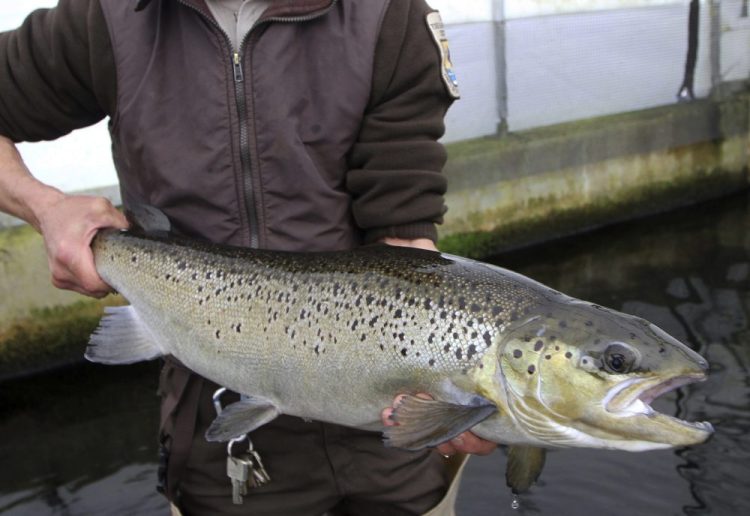The federal government outlined an ambitious, potentially costly new plan to restore Atlantic salmon in the United States, where rivers teemed with the fish before dams, pollution and overfishing decimated their populations.
The Atlantic salmon has declined in the U.S. to the point where the last remaining wild populations of in the U.S. exist only in a handful of rivers in Maine. But the National Oceanic and Atmospheric Administration and U.S. Fish and Wildlife Service are offering a new recovery plan to bring back those fish, which are listed under the Endangered Species Act.
The plan would take decades to fully implement, and it focuses on strategies such as removals of dams, installations of fish passages and increasing the number of salmon that survive in the ocean. It states that the estimated cost is about $24 million per year, not including money federal departments already spend on salmon recovery work.
How that money would materialize at this point is unclear. But the plan gives the species a roadmap to recovery, said Peter Lamothe, program manager for the Maine fish and wildlife complex for the U.S. Fish and Wildlife Service.
“It gives all of the partners involved in this what to shoot for — what we collectively need to achieve to recover the species,” Lamothe said. “It gives us a path forward.”
Atlantic salmon are readily available to seafood consumers because of extensive aquaculture, but the wild fish have been declining in the Gulf of Maine since the 19th century.
Back then, 100,000 adult salmon returned annually to Maine’s Penobscot River, which remains the most important river for the species in America.
By 2017, just over 1,000 salmon returned to Maine rivers, and 849 of them came back to the Penobscot. That constituted about an average year in the modern era, said Dan Kircheis, a fisheries biologist with the National Oceanic and Atmospheric Administration. The fish are born in rivers, head to the sea as they mature and return to rivers to spawn.
Atlantic salmon was so popular that a tradition started in 1912 in which the first salmon hauled from the cold river waters each spring was sent to the president. With the fishery imperiled, that tradition ended after a salmon was presented to then-President George H.W. Bush in 1992.
Efforts to restore Atlantic salmon to East Coast rivers have proven difficult in the past. Biologists decided to abandon a salmon restoration program in the Connecticut River in 2012 because not enough adult fish were returning to the river to reproduce. In Maine, natural spawning of returning salmon is supplemented by a hatchery program, the federal agencies said.
The new recovery plan takes the place of a 2005 plan and expands the scope of recovery of the salmon to include all the remaining wild populations from the Androscoggin River, which runs from New Hampshire into western Maine and leads to Merrymeeting Bay, to the Dennys River, near the Canadian border. Its goals include improving connectivity between the fish’s ocean and freshwater habitats, maintaining the genetic diversity of populations over time and increasing the number of spawning adults, the federal agencies said.
The U.S. fishery for wild Atlantic salmon is long closed, but the fish are still harvested off of Greenland. A successful conservation program could make up for that loss of salmon by improving their survival in rivers, said John Burrows, director of New England programs for the Atlantic Salmon Federation.
“Our biggest sources of mortality happen before Greenland,” he said. “And if we can improve our rivers, we can in many ways compensate for that loss in the ocean.”
Send questions/comments to the editors.



Success. Please wait for the page to reload. If the page does not reload within 5 seconds, please refresh the page.
Enter your email and password to access comments.
Hi, to comment on stories you must . This profile is in addition to your subscription and website login.
Already have a commenting profile? .
Invalid username/password.
Please check your email to confirm and complete your registration.
Only subscribers are eligible to post comments. Please subscribe or login first for digital access. Here’s why.
Use the form below to reset your password. When you've submitted your account email, we will send an email with a reset code.